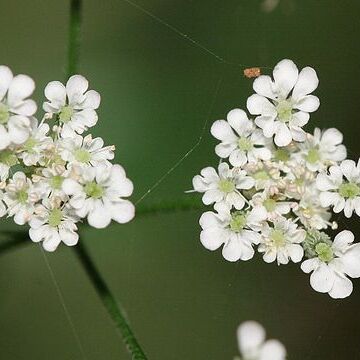Herbs annual or sometimes perennial, bristly, hispid or appressed pubescent throughout. Stem erect, much branched, ridged, leafy throughout. Leaf blade 1–2-pinnate or pinnately decompound; ultimate segments lanceolate to oblong, densely toothed to deeply lobed, both surfaces strigose with appressed hairs. Umbels loosely compound or capitate, terminal and/or lateral; bracts few or absent; rays 2–12, spreading-ascending, or umbellules sessile; bracteoles 2–8, linear or subulate. Calyx teeth small, triangular to acute-lanceolate. Petals white or purplish red, obovate, with a narrow inflexed apex, appressed-strigose on abaxial surface. Stylopodium thick, conic; styles short. Fruit round-ovoid or oblong, flattened laterally; primary ribs filiform, setulose, lateral ribs displaced onto the commissural surface; secondary ribs hidden by dense, upwardly hooked spines (Chinese taxa) which occupy the entire interval; vittae 1 under the secondary ribs, 2 on commissure. Seed flattened dorsally in cross section, face concave. Carpophore bifid at apex, cleft for 1/3–1/2 of its length.
Annual to perennial erect herbs, retrorsely pubescent. Leaves pinnately divided. Umbels compound, rays often few. Involucres many to 0, involucels many. Flowers white or reddish, outer ones radiating. Calyx teeth triangular, acute. Petals cuneate or obovate, emarginate, with inflexed tips. Disk continuous with the base of the styles. Fruits ovate to oblong, laterally subflattened, constricted at the broad commissure; mericarps with primary and secondary ribs obscure or subprominent, lateral ribs in the commissure, muricate-setose, inner face sulcate; carpophore entire or 2-fid.
Hairy annual, rarely biennial, herbs. Lvs 1-3-pinnate; segments broad or narrow. Umbels compound, pedunculate or subsessile and lf-opposed; bracts present or 0, simple; bracteoles several, simple. Petals white to pinkish, sometimes irregular, with apex entire and inflexed; calyx teeth evident or 0. Fr. cylindric to ovoid, slightly flattened laterally, not beaked, tuberculate or spinous; commissure narrow; primary ribs slender, obscured by spines, ciliate; vittae solitary.
Fr ovoid to narrowly oblong, flattened laterally, mostly ± beset with glochidiate and minutely barbellate prickles concealing the ribs; carpophore cleft to half its length; umbels lateral or also terminal; invol of a few small bracts, or wanting; rays few–10; bractlets few, narrow; pedicels few and usually very short; pet white; stylopodium broadly conic; branching annuals with once to thrice pinnate, ternate-pinnate, or decompound lvs. 15, Eurasia, n. Afr.
Fruit ovoid to linear; primary ribs filiform, covered with spiny bristles; secondary ribs indistinct in intervals between the primary ribs, with numerous glochidiate spines.
Seed dorsally flattened, with a concave face towards the commissure, lateral margins of the endosperm not incurved.
Petals white to pinkish, with an inflexed apex; outer petals radiate in some species.
Bracts present or absent, rays 2 to numerous (obsolete in subcapitate species).
Erect or procumbent annual (or rarely biennial) herbs with obvious tap roots.
More rarely the spines of 1 or both mericarps replaced with tubercles.
Umbels compound (sub-capitate in some species), terminal and lateral.
Carpophore 2-cleft at the apex or split to one half of its length.
Vittae solitary in the intervals and 2 in the commissural face.
Leaves pinnate to 3-pinnate with sheathing petioles.
Bracteoles narrowly subulate.
Stylopodium shortly conical.
Calyx teeth small.

